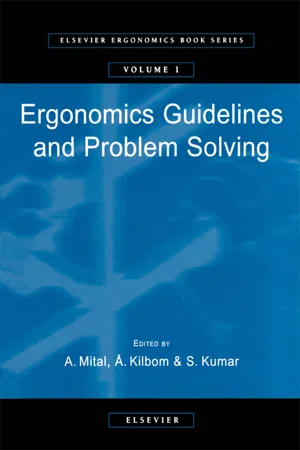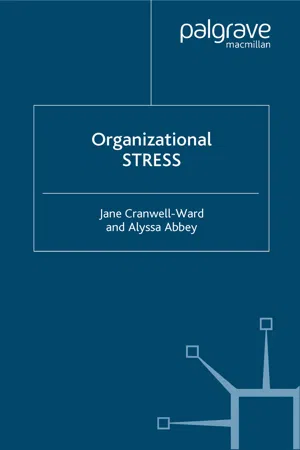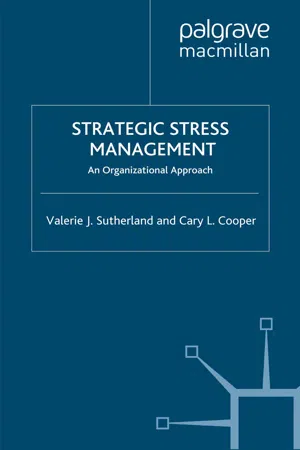Business
Personal Stress Management
Personal stress management involves the practice of techniques and strategies to cope with and reduce stress in one's personal and professional life. This can include activities such as exercise, mindfulness, time management, and seeking social support. By effectively managing stress, individuals can improve their overall well-being and productivity.
Written by Perlego with AI-assistance
Related key terms
1 of 5
5 Key excerpts on "Personal Stress Management"
- eBook - ePub
- A. Mital, Å. Kilbom, S. Kumar(Authors)
- 2000(Publication Date)
- Elsevier Science(Publisher)
For example, Howard et al. (1975) determined that the most successful strategies for coping with stress used by managers were changing to a non-work activity, building better resistance through regular sleep and good health habits, separating work and non-work life, talking with coworkers and engaging in physical exercise. Many of these techniques have been associated with lower stress levels in intervention studies, for example Fremont and Craighead (1987) found that exercise programmes helped to control the level of emotional stress. It should be pointed out, however, that the behaviours shown to be used by individuals who cope successfully with stress tend to be emotion-based strategies which have little effect on min-imising actual exposure to work stressors (Pearlin and Schooler, 1978). Problem-based strategies are needed to cope with the source of stress. This suggests that the strategies that people spontaneously generate to cope do not tackle the real causes of their stress problems, but only help to tolerate them. It can be argued, therefore, that workers need training to help deal with work stressors, but that this training must emphasise problem-based strategies, and it must be linked to other organisational strategies to reduce their exposure to stressors. Implementing individual interventions: Individual stress management in organisations normally takes one or both of two forms, training programmes conducted usually by a consultant expert and Employee Assistance Programmes. The individual stress management strategies described in the preceding discussion would typically be conducted as part of a training programme. Techniques like muscle relaxation, meditation and time management are taught in workplaces often in a general health promotion context rather than in response to a known problem - eBook - PDF
- J. Cranwell-Ward, A. Abbey(Authors)
- 2005(Publication Date)
- Palgrave Macmillan(Publisher)
PART V Understanding and Dealing with Stress An Individual Perspective 21 Introduction Organizations are made up of individuals, so to manage organizational stress as effectively as possible, each individual needs to learn how best to manage stress. Of course, each employee has a unique personality, outlook, responsi- bilities, and set of circumstances, so each person’s solution to pressure and stress will be quite different. Part V was written largely to speak to the indiv- idual reader, but the explanations and suggestions will also help managers and colleagues to understand and help others. Part V also presents a case for giving all employees the benefits of learning about coping strategies for stress through a training program. Understanding what stress is and the effects it has is an important starting point for anyone in managing stress. Chapter 22 discusses the symptoms of stress that many people feel, but would not necessarily be obvious to the outside world. It explains how those symptoms are linked to the physiology of stress and suggests how individuals could assess stress in themselves. Chapter 23 tackles the question of whose responsibility it is to manage stress levels and suggests how one can feel more in control. Chapters 24 and Chapter 25 cover a large range of individual coping strategies for stress. Nearly all coping strategies for stress will fall into one of four broad categories: 1. Managing and improving personal perception 2. Managing emotions and increasing emotional energy 3. Building physical and mental resilience 4. Acceptance of circumstances and ability to be peaceful. Once an individual decides on a set of strategies, those strategies must be put into action, and that is where many people go wrong in managing their own stress levels. They know what it is they should be doing, but they do not do it. Chapter 26 will look at some of the excuses, and real reasons, for failing to look after one’s self and manage stress effectively. - eBook - PDF
Strategic Stress Management
An Organizational Approach
- V. Sutherland, C. Cooper(Authors)
- 2000(Publication Date)
- Palgrave Macmillan(Publisher)
Therefore, it is suggested that the effects of exposure to stress could be minimized by the use of techniques aimed at improving stress coping processes by the individual. Therefore, secondary prevention is Options for the Mangement of Stress ill the Workplace 189 concerned with the prompt detection and management of potentially deleterious conditions by increasing self-awareness and improving stress management skills. Whilst these strategies are usually conceptualized as 'individual' level stress management options, they also embrace the view of individual employees working within a team or work-group. Newman and Beehr (1979) grouped these strategies into four categories aimed at: I. Psychological condition • planning ahead, managing one's life, • self awareness, • realistic aspirations. 2. Physiological or physical conditions • diet, • sleep, • exercise, • relaxation and meditation, • anger management. 3. Changing behaviour • taking time off for leisure and holidays, • changing celtain aspects of behaviour that are stress inducing, • building social support networks at home and work, • being more assertive. 4. Changing the environment • changing to a less demanding job, • changing to a less demanding organization. It is commonplace for organizations to help individuals to either minimize the effects of exposure to stress, or to learn techniques to cope more effectively with stress. We classify these under two separate headings, namely 'skills training options' and 'healthy lifestyle education and management'. Skills training The term 'skills traInIng options' refers to the fact that the stress management activity is in the provision of training per se. After training, individuals or work groups are required to put their new skills into practice by using them to deal with potentially stressful situations. - eBook - ePub
- Jeremy Stranks(Author)
- 2005(Publication Date)
- Routledge(Publisher)
Everyone is subject to stress at some time in their lives. It may be associated with a range of incidents and situations, such as loss of a job, death of a loved one, problems at work, bullying and harassment by colleagues at work or simply overloading of the job.People would be much happier if they studied the causes of stress in their lives and adapted appropriate strategies for coping with these stressors. This chapter has provided a number of strategies for coping, including personal relaxation and time management, two important aspects of reducing those occasional crises that arise.Questions to Ask Yourself After Reading This Chapter- What do people need to do in order to cope more successfully with the stress in their lives?
- What does relaxation therapy entail?
- Why can organizational change be a source of stress for everyone?
- What are the effects of change on people?
- How can time management be improved?
- What do people need to do in personal crisis situations?
- Do some people need assertiveness training?
- What forms of relaxation therapy are available?
- How do people cope with changes in their personal lives?
- How do people respond to stress?
Key Points – Implications for Employers- For people to cope with the stress in their lives, they must be aware of those factors which create stress (stressors) and their specific stress responses, such as insomnia, digestive disorders or even aggressive behaviour.
- In order to deal with stress, everyone should be trained to develop their own personal coping strategies.
- Change within the organization, in job content, in the management systems and in working arrangements are some of the greatest causes of stress amongst employees.
- Better time management is one of the best ways of coping with stress at work.
- Some people, particularly those who have to deal with members of the public, may benefit from assertiveness training.
- eBook - PDF
- Michael A. Hitt, C. Chet Miller, Adrienne Colella, Maria Triana(Authors)
- 2017(Publication Date)
- Wiley(Publisher)
Organizational Stress Management Organizations can help reduce stress or help managers and associates deal more effectively with stress. To reduce stress, the following actions can be taken. These actions are consis- tent with high-involvement management: • Increase individuals’ autonomy and control. According to the demand–control model, increased control should help keep experienced stress to manageable levels. • Ensure that individuals are compensated properly. According to the effort–rewards imbalance model, proper compensation should help to keep experienced stress to manageable levels. • Maintain job demands/requirements at healthy levels. • Ensure that associates have adequate skills to keep up to date with technical changes in the workplace. • Increase associate involvement in important decision making. • Improve physical working conditions. For example, use ergonomically sound equip- ment and tools. • Provide for job security and career development. Provide educational opportunities so associates can continue to improve their skill sets. Use job redesign and job rotation to expand associates’ skill sets. • Provide healthy work schedules. Avoid constant shifting of schedules. Allow for flextime or other alternative work schedules. • Improve communication to help avoid uncertainty and ambiguity. In addition to actions taken to reduce stress, organizations can help associates and man- agers cope with stress and its effects. Specifically, they can encourage some managers to be “toxin handlers,” and they can implement wellness programs. These are discussed next. Toxin handlers, a term coined by renowned educator and consultant Peter Frost, are people who take it upon themselves to handle the pain and stressors that are part of everyday life in organizations. 105 Frost argues that toxin handlers are necessary for organi- zations to be successful, even though their contributions are often overlooked.
Index pages curate the most relevant extracts from our library of academic textbooks. They’ve been created using an in-house natural language model (NLM), each adding context and meaning to key research topics.




